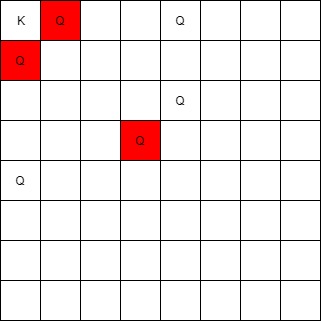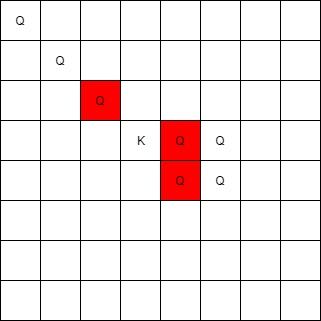Class Solution
java.lang.Object
g1201_1300.s1222_queens_that_can_attack_the_king.Solution
1222 - Queens That Can Attack the King\.
Medium
On an **8x8** chessboard, there can be multiple Black Queens and one White King.
Given an array of integer coordinates `queens` that represents the positions of the Black Queens, and a pair of coordinates `king` that represent the position of the White King, return the coordinates of all the queens (in any order) that can attack the King.
**Example 1:**

**Input:** queens = \[\[0,1],[1,0],[4,0],[0,4],[3,3],[2,4]], king = [0,0]
**Output:** [[0,1],[1,0],[3,3]]
**Explanation:**
The queen at [0,1] can attack the king cause they're in the same row.
The queen at [1,0] can attack the king cause they're in the same column.
The queen at [3,3] can attack the king cause they're in the same diagnal.
The queen at [0,4] can't attack the king cause it's blocked by the queen at [0,1].
The queen at [4,0] can't attack the king cause it's blocked by the queen at [1,0].
The queen at [2,4] can't attack the king cause it's not in the same row/column/diagnal as the king.
**Example 2:**
****
**Input:** queens = \[\[0,0],[1,1],[2,2],[3,4],[3,5],[4,4],[4,5]], king = [3,3]
**Output:** [[2,2],[3,4],[4,4]]
**Example 3:**
****
**Input:** queens = \[\[5,6],[7,7],[2,1],[0,7],[1,6],[5,1],[3,7],[0,3],[4,0],[1,2],[6,3],[5,0],[0,4],[2,2],[1,1],[6,4],[5,4],[0,0],[2,6],[4,5],[5,2],[1,4],[7,5],[2,3],[0,5],[4,2],[1,0],[2,7],[0,1],[4,6],[6,1],[0,6],[4,3],[1,7]], king = [3,4]
**Output:** [[2,3],[1,4],[1,6],[3,7],[4,3],[5,4],[4,5]]
**Constraints:**
* `1 <= queens.length <= 63`
* `queens[i].length == 2`
* `0 <= queens[i][j] < 8`
* `king.length == 2`
* `0 <= king[0], king[1] < 8`
* At most one piece is allowed in a cell.
-
Constructor Summary
Constructors -
Method Summary
-
Constructor Details
-
Solution
public Solution()
-
-
Method Details
-
queensAttacktheKing
-
dfs
-